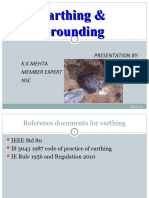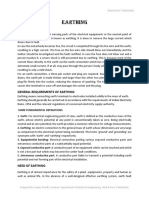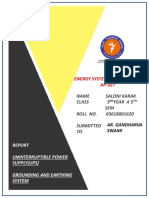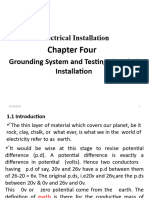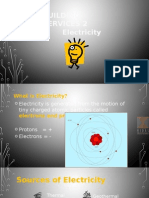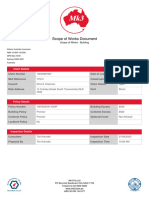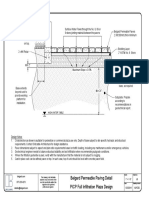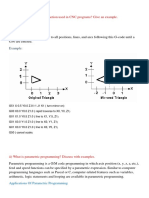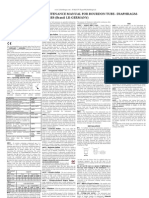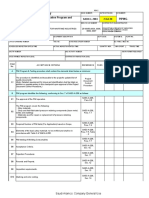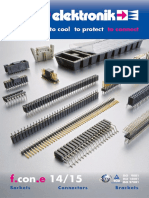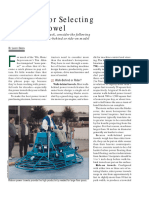Earthing and Protection
Uploaded by
JamesWachiraEarthing and Protection
Uploaded by
JamesWachiralOMoARcPSD|36443438
ELECTRICAL INSTALLATION Prepared by Mr. BRIAN NZIVO M
HEBREWS 11: 1
10. 3-phase, 4-wire system
In this case, 4th or neutral wire is taken from the neutral point as shown in Fig. below..., The area
of X-section of the neutral wire is generally one-half that of the line conductor. If the loads are
balanced, then current through the neutral wire is zero. Assuming balanced loads and p.f. of the
load as cos φ
KNEC QUESTIONS
1. Oct-Nov 2018 KNEC QUESTION: -
a) Draw a labelled block diagram of a diesel power station.
b) Outline three factors to be considered when selecting the site for a diesel
power station
2. June/July 2013
a) Outline three advantages of a nuclear energy over thermal power generating
stations. (3 marks)
b) With an aid of a labelled schematic diagram, explain the operations of the gas
turbine power plant (7 marks)
c) Explain the functions of the hydraulic structures in a hydro-electric power
plants (10 marks)
3. H
4.
43 | P a g e
Downloaded by James maina (wachirajames70@gmail.com)
lOMoARcPSD|36443438
ELECTRICAL INSTALLATION Prepared by Mr. BRIAN NZIVO M
HEBREWS 11: 1
TOPIC 8
EARTHING AND PROTECTION
Objectives
By the end of the topic, the learner should be to; -
i. Explain the terms used in earthing
ii. Purposes for earthing
iii. Parts of an earthing system
iv. Different methods of earthing
v. Over current protection
vi. Test for an earthing system
vii. Relevant IEE regulations
- Earthing refers to the connection to the general mass of the earth.
- A conductor or other metal is said to be earthed when it’s effectively connected to the general
mass of the earth by means of metal rod or other conducting materials.
- Solid earthing is when the metal is connected to earth without the intervention of a fuse,
switch, circuit breakers, resistances, reactor or a solenoid.
REASONS FOR EARTHING
1. To prevent or minimize the risks of electric shocks to human beings and livestock by
providing a common resistance discharge path after currents which would otherwise prove an
injury or fatal to a person in contact with the metal-work associated with the faulty circuits.
2. To reduce the risks of fire hazards
3. To permit sufficient current to flow to earth in case of a fault, to operate the protective
device.
GENERAL PROVISION FOR EARTHING
- The I.E.E Regulation requires that every item, apparatus, appliances and conductor shall be
prevented from giving rise to dangerous earth leakages current by all insulated construction,
by double insulation, by insolation or by earthing of all exposed metal parts. This is required
for insulation where the voltage exceeds low voltage.
- Provision of consumers earthing terminals adjacent to the consumers terminals and an earth
continuity conductor throughout the insulation.
- Connection of all metalwork of wiring system other than current carrying parts…, e.g. cable
sheaths and armour, conduits, ducts, trunking and catenary………., to the earth continuity
conductor. This doesn’t apply to isolated metal parts such as: -
i. Short length of metal used for machines protection of cables having a non-
metallic sheath.
ii. Metal clips for fixing cables,
iii. Metal laps caps,
44 | P a g e
Downloaded by James maina (wachirajames70@gmail.com)
lOMoARcPSD|36443438
ELECTRICAL INSTALLATION Prepared by Mr. BRIAN NZIVO M
HEBREWS 11: 1
iv. Screws, nameplates and catenary wires where insulated hangers are used.
- Connection of all exposed metal-work to the earth continuity conductor.
- Connection of every earthing terminals of the socket outlets to the Earthing Continuity
Conductor (E.C.C)
- Provision and connection to the Earthing Continuity Conductor (E.C.C)
PARTS OF AN EARTHING SYSTEM
Fig 8. 1 parts of an earthing system
i. Consumer Earthing Terminal: -it is a terminal fixed at the consumer’s control unit
(C.C.U) at the intake point. The terminal is directly attached to the casing of the
consumer’s intake point without any point of insulation. It connects both the earth
Continuity Conductor (E.C.C.) from electrical appliances and accessories and the
earthing lead, electrode to the general mass of the earth.
ii. Earthing lead: - It connects the consumer’s earthing terminal to the earthing electrode
that is fixed in the general mass of the earth. The earthing lead is made of copper and
sizes to be used are given in a table provided by the IEE regulations subject to a
maximum of 70mm2. For this reason, the connection of earth leakage circuit breaker of a
cross-sectional area of 25mm2 need to be exceeded. The connection of an earthing lead to
the earthing electrode must be accessible but mechanically protected from mechanical
damage by use of either PVC/ Steel conduits where applicable. Joining should be
professionally soldered, or clamped. Copper clad, aluminium conductors shall not be
used.
iii. Earthing electrode: - refers to as a metal rod or rods, a system of underground metal
pipes or other conducting objects. Used for providing an effectual connection with the
general mass of the earth, and is buried in the ground.
45 | P a g e
Downloaded by James maina (wachirajames70@gmail.com)
lOMoARcPSD|36443438
ELECTRICAL INSTALLATION Prepared by Mr. BRIAN NZIVO M
HEBREWS 11: 1
iv. Earthing Continuity Conductor [E.C.C]: - these are very vital linking conductors
which runs from the consumer’s intake point to various electrical accessories and
appliances such as socket outlets, fluorescent lamps fittings, cooker’s intake points
heating element’s intake points. Always ensure the following: -
o Regularly check, inspect and test the viability of the earthing continuity conductor
for various power outlets and intake points.
o Replace fault Earthing Continuity Conductor immediately you discover its
faultiness.
o Always provide an Earthing Continuity Conductor [E.C.C] to all newly installed
machines, accessories and appliances if the machine or appliances has an earth
link terminal.
o Use the correct cable size as per the IEE regulations (depending on the amount of
current required by the machine or appliances). This prevents the melting up of
conductors before the excess current reaches the earth surface.
o Always ensure all the earthing terminals, plates and links are commonly
interconnected at the consumer’s intake point; from all the appliances and
accessories.
[CRAFT] VARIOUS METHODS USED TO ACHIEVE EARTHING OF AN
INSTALLATION
1. Connection to the metal sheath and armoring of a supply authority’s underground supply
cable.
2. Connection to a continuous earth wire (CEW) provided by a supply authority where the
distribution of electricity is by overhead lines.
3. Connection to an earth electrode.
4. Installation of a protective multiple earthing (PME) system.
5. Installation of automatic fault protection., i.e. Earth Leakage Circuit Breakers (ELCB).
FORMS OF EARTHING ELECTRODE
The earthing electrodes can be any one of the following forms: -
a) Pipes: - a pipe of 200mm diameter cast iron, 2m long which is buried in a coke filled pit.
b) Plates: - a plate electrodes are normally of cast iron buried vertically with the centre
about one metre below the surface. Copper plates may also be used.
- Plate electrodes provides a large surface area and are used mainly where the ground is
shallow (where resistivity is low)
c) Strip: - a copper strip is mostly useful in shallow soil, overlying rocks. The strip should
be buried to a depth of not less 50cm or nearly 2 feet’s.
d) Rods: - Rod electrode are very economical and require no excavation for their
installation.
46 | P a g e
Downloaded by James maina (wachirajames70@gmail.com)
lOMoARcPSD|36443438
ELECTRICAL INSTALLATION Prepared by Mr. BRIAN NZIVO M
HEBREWS 11: 1
- Rods are driven into the ground so that the soil contact with the rod is close and definite.
- Rods are made hard drawn copper with hardened steel tip and a steel driving cap.
TYPES OF EARTH ELECTRODES
a) Plates: -generally made of copper, zinc, steel or cast iron and may be the solid type or lattice
type. Because of their mass, they have to be costly with steel or cast-iron type. Care must be
taken to prevent corrosion of plates and are generally installed at the edge of houses in the
ground (verandas of houses) to about a depth of2.3 metres deep. The plates are installed
relatively very near the surface of the ground which leads to resistance fluctuations due to
seasonal changes throughout the year.
b) Rods: - they are less costly than other electrodes to install. They don’t require much space,
convenient to test and do not create large voltage gradient because the earth fault current is
dissipated vertically.
- Deeply installed rods are not subject to seasonal resistance changes. The solid copper rods
give excellent conductivity and is resistant to corrosion, but its not ideal for driving into deep
soil as its soft and may bend when it comes into contact with an obstacle.
- The bimetallic rod has a steel core-card and copper on them. The steel core gives the
necessary rigidity and copper extremely gives good conductivity and high resistance to
corrosion.
c) Strips: - copper strips used where the soil is shallow and outlies rocks. It should be buried in
a trench to a depth of not less than 50cm and should be not used where there is a possibility
of the ground being disturbed e.g. on farmland. The strip electrode is most effective if buried
in clinches under hedge rooms where the biological action arising from the decay or
vegetation maintains a conducive soil resistance.
d) The earth mats: - it consists of copper buried in trenches up to 1m deep. The mat can be laid
out either linearly or in start-form and terminated at the down leads from the transformer or
other items or equipment to be earthed. The total length of conduction used can be expensive.
The most common areas where this system is used are where rocks are present near the
surface of the soil, making deep excavation impracticable. As with the plate electrodes, this
method of earthing is subject to seasonal changes in resistance.
e) The cable sheaths: - these form a metallic return path and are provided by the supply
undertaking. They are particularly useful where an extensive underground cable system is
available, the combination of sheath and armoring forms a mass effective earth electrode. In
most cases, the resistance to earth of such a system is less than 1Ω, cable sheath is ……….
more used to provide a direct metallic connection for the return of fault current to the neutral
of a supply system rather as means of direct connection with earth; thus, even though such
cables are served with gradual deterioration of the final jute or hessian serving.
METHODS OF EARTHING
There are various methods of earthing such as: -
- Direct method of earthing
- Protective multiple earthing [PME] system.
47 | P a g e
Downloaded by James maina (wachirajames70@gmail.com)
lOMoARcPSD|36443438
ELECTRICAL INSTALLATION Prepared by Mr. BRIAN NZIVO M
HEBREWS 11: 1
DIRECT EARTHING METHOD
- This means connecting to an earth electrode of some recognized types of reliance on the
effectiveness of overcurrent protection devices.
- For protection against shock and fire hazards in the event of an earth fault.
- A potential difference will exist between earthed metal work and the general mass of the
earth to which the electrode is connected in case of an earth fault.
- This potential difference will depend on the line voltage, the sub-station or supply
transformer, earth resistance, the line resistance, the fault resistance and earth resistance at
the point of installation.
- Direct earthing connection are made with electrodes in the earth at the consumer’s premises
or the use of sheaths in underground cables, but the latter method is more generally used to
provide a direct-metallic connection for the return of earth fault current to the neutral of the
supply system. The earth electrode can take a number of forms and can be either a single
connection or a network of multiple electrodes
PROTECTIVE MULTIPLE EARTHING [PME]
Fig 8. 2 a typical protective multiple earthing system(PME)
- This form of earthing is also known as continuous neutral earthing [C.N.E.]. The system uses
the neutral of the mains power supply as the earthing point in all the protected metal-work in
an installation to this common point.
- The consumers earthing terminals, all on to earth, first are converted to neutral points, with
an intention to ensure that sufficient current flows under fault conditions to operate the
excess current protective devices. There are two main hazards associated with protective
multiple earthing (P.M.E] system.
- First, due to the increased earth fault current is encouraged to flow; there is an enhanced fire
risk during the time it takes for the protective device to operate. Also, it’s essential to ensure
that the neutral conductor cannot rise up to dangerous potential with respect to earth. This is
because the interconnection of neutral and protective metal-work would automatically extend
48 | P a g e
Downloaded by James maina (wachirajames70@gmail.com)
lOMoARcPSD|36443438
ELECTRICAL INSTALLATION Prepared by Mr. BRIAN NZIVO M
HEBREWS 11: 1
the resultant shock risk to all the protected metalwork on every installation connected to this
particular supply distribution network.
- Due to this hazard, the following requirements must be met: -
a) The neutral conductor must be earthed at a number of points in the systems and the
maximum resistance from neutral to earth must not exceed 10Ω. An earth electrode should
also be installed at every consumers installation.
b) There must be no fusible cut-out, single pole switch, removable links or automatic circuit
breakers in the neutral conductor in the consumers installation.
c) The neutral conductor at any point must be made of same materials and be at least of equal
cross-sectional area as the phase conductor.
- P.M.E. can only be applied to a consumer’s installation, if the supply authority’s feeder is
multiple earthed.
Advantages of protective multiple earthing system
There is low impedance path for fault current to flow to the mass of the earth via the neutral
conductor.
Impedance to earth is low even though individual earth impedances may be high due to
multiple earthing connections.
Disadvantages of protective multiple earthing system
One needs to seek authorization from the supply authority in order to use this earthing
method.
Earth current may circulate both multiple earth electrodes.
Shock may arise if any earth metal work associated with the system is not bonded to the
neutral conductor.
OTHER METHODS OF EARTHING
ELECTRICAL PROTECTION
- Protection refers to the process of……….
REASONS FOR ELECTRICAL PROTECTION
(i) To avoid
(ii) To
(iii) To
(iv) To
- All electrical equipment’s, appliances and circuits must be protected against damage arising
from one or more of the following abnormal conditions such as; -
(i) Overloading or overcurrent,
(ii) Short circuit or insulation failure,
(iii) Earth fault,
(iv) Over voltage,
(v) Low voltage,
(vi) Reverse power flow in case of parallel feeders.
49 | P a g e
Downloaded by James maina (wachirajames70@gmail.com)
lOMoARcPSD|36443438
ELECTRICAL INSTALLATION Prepared by Mr. BRIAN NZIVO M
HEBREWS 11: 1
- Excess current protection is one of the requirements of statutory and I.E.E Regulations. The
IEE Regulation states that; - every consumer’s installation shall be adequately controlled by
switchgears that are readily accessible to the consumers which shall incorporate means of
excess current protection.
- The means of excess current protection required by the regulations shall comprise of a fuse
placed in each live conductor of the supply or a circuit breaker having an excess current
release fitted in each live conductor of the supply.
- The means of excess current referred above may be omitted if: -
i. The rating of all cables connected between the supply undertaking fuse or circuit breaker
and the consumer’s sub-circuit fuses or CBs is not loss than the rating of the supply
undertaking’s fuse or CBs,
ii. The excess current protective devices protecting all circuits controlled by the switchgear
are located within the same enclosure as the switchgear or alternatively are located
immediately adjacent to it.
- All circuit’s requires protection against the effects of excess current which includes increased
temperatures in conductors (leading to deterioration of insulation), hence increased fire
hazards, excess voltage drop and deterioration of conductor joints and termination.
TERMS USED IN ELECTRICAL PROTECTION
a) A fuse; - a device for opening a circuit by means of a fuse element designed to melt when an
excessive current flow through it. It consists of a fuse base and a fuse link.
b) A circuit breaker; - a mechanical device for making and breaking a circuit both under
normal and under-abnormal circumstances such as those of a short-circuit. The circuit is
being broken automatically.
c) Current rating; - this is a current, less than the minimum fusing current stated by the
manufacturers as current that the fuse can carry continuously without deterioration of the
fusing element or the maximum current that a fuse will carry indefinitely without undue
deterioration of the fuse-element.
d) Fusing/fuse element; -
e) Fusing current; - this is the minimum current that will cause the fuse to operate in a
specified time under the prescribed conditions, or the minimum current that will blow the
fuse.
f) Fusing factor; - this is the ratio, greater than the unity, of the rated minimum fusing current
to the current rating.
Fusing factor = minimum fusing current / current rating
g) Breaking capacity; - this is the greatest prospective current that may be associated with a
fuse under prescribed conditions of voltage and power factor or time constant.
50 | P a g e
Downloaded by James maina (wachirajames70@gmail.com)
lOMoARcPSD|36443438
ELECTRICAL INSTALLATION Prepared by Mr. BRIAN NZIVO M
HEBREWS 11: 1
h) Discrimination; - the ability of fuses and circuit breakers to interrupt the supply of a faulty
circuit without interfering with the source of supply of the healthy circuits. This requires that
a larger fuse near the source supply will remain unaffected by fault currents which would
cause a smaller fuse, for that form the same, to operate.
i) Close excess current protection; - excess current protection which will operate four hours at
1.5 times the designed load current of the circuit which it protects.
j) Coarse excess current protection; - excess current protection which will not operate within
four hours at 1.5 times the designed load current of the circuit which it protects.
VARIOUS FORMS OF ELECTRICAL PROTECTION
- This are the precautions taken to prevent damage to the various parts of an electrical circuit
such as the; - wiring systems, electrical accessories, heating appliances and other electrical
apparatus.
- Protection entails prevention of damage, generally of physical nature.
- The various forms of protection comprise; -
Protection against mechanical damage,
Protection against heat or fire,
Protection against corrosion,
Protection against excess current.
PROTECTION AGAINST MECHANICAL DAMAGE
- Mechanical damage is basically the term used in describing the physical damage and harm
sustained on some portion or various parts of electric circuits generally by impacts of hitting
the cables with hammer or by abrasion or by collistance.
- The IEE Regulation B25-30 states that cables must be prevented against mechanical damage
during their normal condition of service. The conduits, ducts, trunking and casing must be
additionally protected.
- Protection against mechanical damage is an important factor in the choice of a wiring system
or fitting for a particular situation.
REGULATIONS FOR THE PROTECTION OF CONDUCTORS AND CABLES
AGAINST MECHANICAL DAMAGE
i. Cables installed under floors should either be in position where they are not liable to damage
by contact with the floor.
ii. All non-sheathed cables must be enclosed in a conduit, duct or trunking.
iii. Non-metal sheathed cables exposed to direct sunlight should be covered with a black type of
P.C.P. / P.V.C.
iv. Cables which form part of a lift installation and are running in the lift should be armoured or
copper sheathed.
v. In order to prevent damage to the cables, during installation, holes in structural metal work
through which cables pass must be brushed
51 | P a g e
Downloaded by James maina (wachirajames70@gmail.com)
lOMoARcPSD|36443438
ELECTRICAL INSTALLATION Prepared by Mr. BRIAN NZIVO M
HEBREWS 11: 1
PROTECTION AGAINST HEAT OR FIRE
- Electric fires are generally caused by; -
A fault, defect or omission in the wiring system.
Faults or defects in the appliances.
Operation or abuse of electrical circuits through overloading.
- Protection against heat or fire entails that the installation must be fire proof or flame proof.
- The IEE Regulation B A0 requires that when installing conductors in any building, it is
necessary to avoid gaps or holes in the walls or floors which may assist the spread of fire.
- The IEE Regulation B 3A-38 indicates that the installation must be prevented against the risk
of overheating.
- Holes and other openings must be made good with an incombustible material.
- Where vertical cables duct is installed, non-ignitable materials must be fixed at intervals
inside the ducts.
- There are two types of flame prove apparatus; -
i. Mining gear – which is used with armoured cables.
ii. Industrial gear – which is used with solid drawn steel conduits.
- Mining gear is known as group one gear and comes into contact with only fire hazards
(methyonel)
- Industrial gear is installed in situation where a wide range of explosive gases and liquids are
present e.g.,
a) explosive gases and vapors
b) Inflammable liquids
c) Explosive ducts
- When considering the protection of cables against damage by heat or fire, three possible
sources of heat are considered; -
a) The ambient temperature of the surrounding,
b) Rise in temperature of the cables,
c) Transfer of heat from terminal apparatus
PROTECTION AGAINST CORROSION
- Corrosion is the electrochemical process or reaction by which metal reverts. In the presence
of moisture to a more stable form usually of the type in which it is found in nature.
- Corrosion is normally caused by the flow of direct electrical current which may be self-
generated or imposed from external source e.g., earth leakage current.
PRECAUTION AGAINST OCCURRENCE OF CORROSION
i. Prevention of contact between two dissimilar metals e.g., copper and aluminium.
ii. The prohibition of soldering fluxes which remains acidic or corrosive at the completion
of soldering operation.
iii. The protection of cables, wiring systems and equipment’s against the corrosive action of
water, oil and dampness.
52 | P a g e
Downloaded by James maina (wachirajames70@gmail.com)
lOMoARcPSD|36443438
ELECTRICAL INSTALLATION Prepared by Mr. BRIAN NZIVO M
HEBREWS 11: 1
iv. The protection of metal sheath of cables and metal conduits where they come int contact
with lime, cement and plaster hardwood.
Classes of fuses
FUSING FACTOR
CLASS EXCEEDING NOT EXCEEDING
P 1.0 1.25
Q1 1.25 1.50
Q2 1.50 1.75
R 1.75 2.50
PROTECTION BY USE OF FUSES
- Fuse offers a means of excess current protection in its basic form; the fuse consists of a short
length conductor of a suitable material. In most cases, it is in the form of a wire which has a
very small cross-sectional area compared to the circuit conductor.
- A current flow which is greater than the current rating of the wire (fusing element); the fusing
element(wire) will get very hot and eventually melt.
TYPES OF FUSES
i. Cartilage fuses; -
- It consists of a ceramic or porcelain tube containing the fusing element.
- The fuse is filled with a non-fusible sand which serves the purpose of quenching the
resultant heat produced(generated) when the element melts, the fusing factor is between 1.25
to 1.75 depending on the type of the fusing/ fuse elements.
Fig 8. 3 a typical cartilage fuse
Advantages of cartilage fuses
a) The fuse is designed in such a way that it is enclosed hence no destruction of the fuse
element.
b) The fuse rating is accurately given.
Disadvantages of cartilage fuses
53 | P a g e
Downloaded by James maina (wachirajames70@gmail.com)
lOMoARcPSD|36443438
ELECTRICAL INSTALLATION Prepared by Mr. BRIAN NZIVO M
HEBREWS 11: 1
a) The fusing element is more expensive to replace.
b) They are designed in such a way that they cannot be interchanged expect with their own
group.
c) They are unsuitable for use for high rated voltage-current circuits.
ii. Rewireable fuses; -
- A rewireable fuse is a simple and relatively cheaper type of over-current protective device.
- It consists of a porcelain bridge and a fuse base.
- The fusing/fuse element is connected between the terminals of the bridge.
- An asbestos tube is fitted in the fuse to minimize the effects of arcing formed when the fuse
element melts.
- The fusing factor of a rewireable fuse is roughly 2 with a protective asbestos pad which
eventually reduces the factor to 1.9. This implies that a fuse-element rated at 10A will melt
when 10 x 2 = 20A flows in the circuit. It also implies that a 1.00mm2 conductor (which has a
current rating of 11A) may, in an overload condition, be made to carry as much as 50 percent
overload without the fuse coming into action; the cable is thus run on overload which may
lead eventually to a fault.
Fig 8. 4 A typical rewireable fuse
Advantages of a rewireable fuses
a) It is not expensive.
b) It is easy to replace the fusing element.
c) It is simple in construction.
Disadvantages of a rewireable fuses
a. The ease with which an inexperienced person can replace a ‘blown’ fuse element with a
wire of incorrect gauge or type.
b. It takes time before blowing or melting hence it can cause physical damage to circuit
conductors and equipment’s being protected.
c. It doesn’t offer discrimination between a surge and a continuous fault current; - this
means it is possible, in certain installation conditions, for a 15A fuse-element to melt
before a 10A fuse-element. Also, a rewireable fuse is not capable of discriminating
between a momentary high current e.g. motor starting current and a continuous fault
current.
d. It’s very difficult to know the rating, this renders this fuse unsuitable for circuits which
requires discrimination protection.
e. The fuse element is always at a fairly high temperatures when in use, this leads to it’s
oxidization hence the fuse element deteriorates very fast.
54 | P a g e
Downloaded by James maina (wachirajames70@gmail.com)
lOMoARcPSD|36443438
ELECTRICAL INSTALLATION Prepared by Mr. BRIAN NZIVO M
HEBREWS 11: 1
f. They are classified by offering course and close excess current protection i.e., the device
will take longer than 4 hours to come into operation when a current of 1.5 times the
designed low current of the associated circuit flows through the fuse element.
iii. HIGH BREAKING CAPACITY FUSE (H.B.C)
- It has ceramic with some metal cups.
- The fuse element is silver of special shape stripes. The stripes are surrounded by chemically
purified silver.
- When an overload occurs, breaking the fuse element, there is formation of an ore.
- These fuses are commonly used to protect current in large industry, mains cables, motor
circuit for back-up protection for machinery.
Advantages of high breaking capacity fuse (H.B.C)
a) There are discriminative in nature (will not blow when there is a surge).
b) Has a short time operation, hence can be used for short circuits.
c) Is able to
Disadvantages of high breaking capacity fuse (H.B.C)
a) It very expensive
b) Requires an experienced person to replace.
iv. Protection by circuit breakers
- It is a mechanical device for making and breaking of circuit both under normal and abnormal
conditions.
- The circuit breaker is selected for a particular duty taking the following into consideration; -
The normal current it will have to carry,
The amount of current which the supply system will feed into the circuit fault.
Functions of a circuit breakers
It permits the installation of appliances it will protect to be used up to its full rated
capacity.
To protect devices to be used in dangerous conditions.
They are to provide a closer and more accurate degree of excess current protection.
55 | P a g e
Downloaded by James maina (wachirajames70@gmail.com)
lOMoARcPSD|36443438
ELECTRICAL INSTALLATION Prepared by Mr. BRIAN NZIVO M
HEBREWS 11: 1
- The circuit breaker has a mechanism which when it is in a closed position, holds the contact
together. The contacts are separated when the release mechanism of a circuit breaker is
operated by hand or automatically by magnetic or thermal means.
Magnetic tripping
- It employs a solenoid which is a coil with an iron slug. The normal circuit current which
flows through the coil is not sufficiently strong to produce a significant magnetic flux.
- As the circuit current increases the magnetic field strength increases to cause the iron slug to
move within the solenoid and collapses the attached tripping linkage to open the contact.
Thermal tripping
- It uses a heat sensitive bimetallic element. When the element is heated to a predetermined
temperature, the resultant deflection is arranged to trip the circuit breakers.
- The time taken to heat the element to this temperature provides the necessary time-delay
characteristics.
- The bimetal element may be arranged to carry the circuit current, and so be directly heated.
When a heavier overload occurs, the magnetic trip coil operates quickly to disconnect the
faulty circuit.
v. D
TOPIC 9
BATTERY CHARGING
Objectives
By the end of the topic the learner should be able to: -
i) Explain the constant voltage charging methods
- Constant current charging
- Constant voltage charging
- Float battery charging
- Trickle battery charging
ii) Describe the maintenance of various batteries
- Lead-acid cells
- Alkaline cells
- Zinc air
Battery charging methods
56 | P a g e
Downloaded by James maina (wachirajames70@gmail.com)
You might also like
- Testing and Commissioning of Electrical Equipment (Safety Management)No ratings yetTesting and Commissioning of Electrical Equipment (Safety Management)15 pages
- Earthing and Electrical Grounding Installation100% (4)Earthing and Electrical Grounding Installation19 pages
- Earthing and Lightning Protection SystemNo ratings yetEarthing and Lightning Protection System31 pages
- Earthing - Earthing Req. Relevent CodesNo ratings yetEarthing - Earthing Req. Relevent Codes66 pages
- Earthing and Earth Leakage Protection 1No ratings yetEarthing and Earth Leakage Protection 122 pages
- Birla Vishvakarma Mahvidyalaya: Electrical EarthingNo ratings yetBirla Vishvakarma Mahvidyalaya: Electrical Earthing33 pages
- Unit 3 - Concept of Electrical Earthing or GroundingNo ratings yetUnit 3 - Concept of Electrical Earthing or Grounding4 pages
- Difference Between Earthing, Grounding & Neutral: NeutraNo ratings yetDifference Between Earthing, Grounding & Neutral: Neutra5 pages
- Scet Chemical 1 Year Bee PPT Group-3: Earthing and Its TypesNo ratings yetScet Chemical 1 Year Bee PPT Group-3: Earthing and Its Types22 pages
- Earthing System: Presentation by Pic Earthing Technology100% (2)Earthing System: Presentation by Pic Earthing Technology37 pages
- Earthing: Ronald Siakama Senior Protection Engineer Kenya PowerNo ratings yetEarthing: Ronald Siakama Senior Protection Engineer Kenya Power47 pages
- Earthing of Equipment in Distribution SystemNo ratings yetEarthing of Equipment in Distribution System13 pages
- Objectives: Earthing: Electrical SafetyNo ratings yetObjectives: Earthing: Electrical Safety18 pages
- Earthing in Industrial and Pharmaceutical Plants100% (1)Earthing in Industrial and Pharmaceutical Plants28 pages
- Unit 10 Simple Harmonic Motion and WavesNo ratings yetUnit 10 Simple Harmonic Motion and Waves12 pages
- Nind Vessman - Scope of Works - Insured ReportNo ratings yetNind Vessman - Scope of Works - Insured Report3 pages
- X-Plane Citation X Pilot Operating ManualNo ratings yetX-Plane Citation X Pilot Operating Manual80 pages
- Belgard Permeable Paving Detail PICP Full Infiltration Plaza DesignNo ratings yetBelgard Permeable Paving Detail PICP Full Infiltration Plaza Design1 page
- Overhead Design Manual: © ENERGEX 2007 BMS 01613 2.0 Last Update: 15/01/2007No ratings yetOverhead Design Manual: © ENERGEX 2007 BMS 01613 2.0 Last Update: 15/01/200722 pages
- 091flrfv2 Digital Programmable Thermostat ManualNo ratings yet091flrfv2 Digital Programmable Thermostat Manual10 pages
- 95-01 - Panel Installation, Instrument: Illustrated Parts DataNo ratings yet95-01 - Panel Installation, Instrument: Illustrated Parts Data15 pages
- Sac Inspection Checklist: Piping-Review of Positive Material Identification Program and Testing ProcedureNo ratings yetSac Inspection Checklist: Piping-Review of Positive Material Identification Program and Testing Procedure2 pages
- Recovery of Noble Metals From Jewellery Wastes100% (2)Recovery of Noble Metals From Jewellery Wastes119 pages
- Evaluation of Operational Strategy in Area 4 PT Tirta Investama (AQUA) PandaanNo ratings yetEvaluation of Operational Strategy in Area 4 PT Tirta Investama (AQUA) Pandaan19 pages
- Schwing Stetter India Locations & PartsNo ratings yetSchwing Stetter India Locations & Parts71 pages
- Concrete Construction Article PDF - Checklist For Selecting A Power TrowelNo ratings yetConcrete Construction Article PDF - Checklist For Selecting A Power Trowel3 pages





